Many passengers injured during Singapore Airlines’ turbulence flight require spinal surgery and six others have brain injuries, Bangkok hospital reveals
Brutal turbulence that hit a Singapore Airlines flight on Tuesday morning left 22 passengers with significant spinal cord injuries and six with brain and skull injuries, hospital officials said today.
Twenty people remain in intensive care and a 73-year-old British man died after the Boeing 777 flying from London’s Heathrow Airport to Singapore suddenly descended sharply after hitting turbulence over the Andaman Sea on Tuesday.
Pilots performed an emergency landing in Bangkok, Thailand, where more than 100 people received medical treatment and about 80 people were rushed to two hospitals.
But this morning it was revealed by Thai doctors that many of the 22 passengers with back injuries will require surgery, and that 40 people are still in hospital.
Adinun Kittiratanapaibool, director of Samitivej Srinakarin Hospital in Bangkok, said the oldest patient at the hospital is 83 years old and the youngest is a two-year-old child who suffered a concussion, he added.
Ten Britons, nine Australians, seven Malaysians and four Filipino citizens were among the 40 people hospitalized, according to a presentation by Adinun.
Australian national Keith Davies suffered several injuries during the flight, while his British wife Kerry remains in intensive care
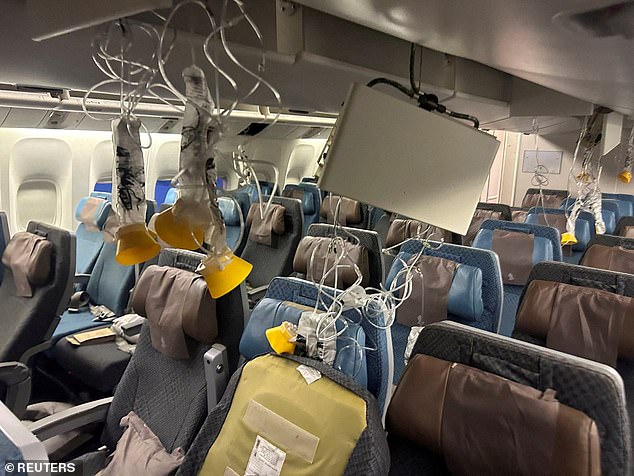
The interior of Singapore Airlines Flight SQ321 is pictured after an emergency landing at Suvarnabhumi International Airport in Bangkok, Thailand, May 21, 2024.
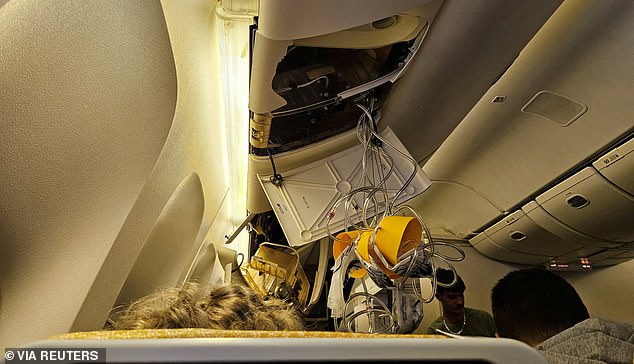
The interior of Singapore Airlines Flight SQ321 is pictured after an emergency landing at Bangkok’s Suvarnabhumi International Airport, in Bangkok, Thailand, on May 21, 2024 in this handout image
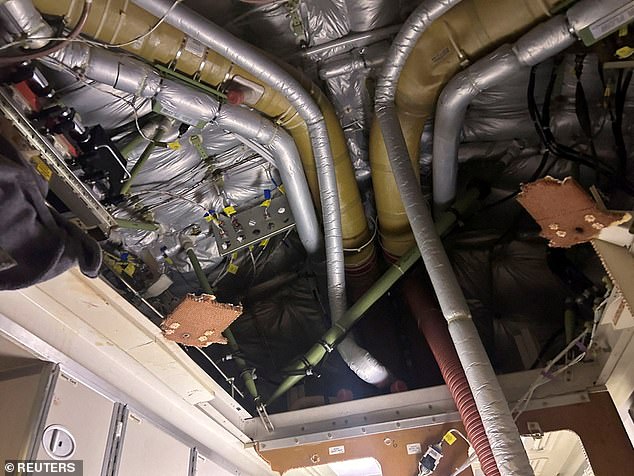
The interior of Singapore Airlines Flight SQ321 is pictured after an emergency landing at Suvarnabhumi International Airport in Bangkok, Thailand, May 21, 2024

A man is carried off the plane by Thai emergency services after landing in Bangkok
It remains unclear what exactly caused the turbulence that sent the plane, which was carrying 211 passengers and 18 crew members, plunging some 6,000 feet in just 180 seconds.
But passengers describe the “sheer terror” of the shaking plane, flying loose objects and injured people lying paralyzed on the floor of the plane.
Travelers said people standing in the aisle were hit against the ceiling and ‘somersaulted’, while others suffered nasty cuts and blood flowed from their wounds.
In one of the latest accounts of the chaos on board, 43-year-old Malaysian Amelia Lim described being face down on the ground.
‘I was so scared… I saw so many people on the ground, they were all bleeding. There was blood on the floor, but also on the people,” she told online newspaper Malay Mail.
The woman who had been sitting next to her “stood motionless in the aisle and could not move, probably with a hip or spinal injury,” she added.
Thai authorities say the deceased British man, Geoff Kitchen, likely suffered a heart attack.
Passengers described how the flight crew tried to revive him by performing CPR for about 20 minutes.
Meanwhile, Australian citizen Keith Davis said his British wife Kerry was among the Britons who suffered critical injuries and are now in intensive care at Samitivej Srinakarin Hospital in Bangkok.
He did not reveal what Kerry’s injuries were, but said he wants her medically evacuated to their home in Adelaide.
Davis’ injuries were clearly visible on his face with a dark bruise and swelling under his right eye when he visited a hospital cafe.
He also had a bandage wrapped around his head after suffering a cut from hitting his head on the panel above his seat.
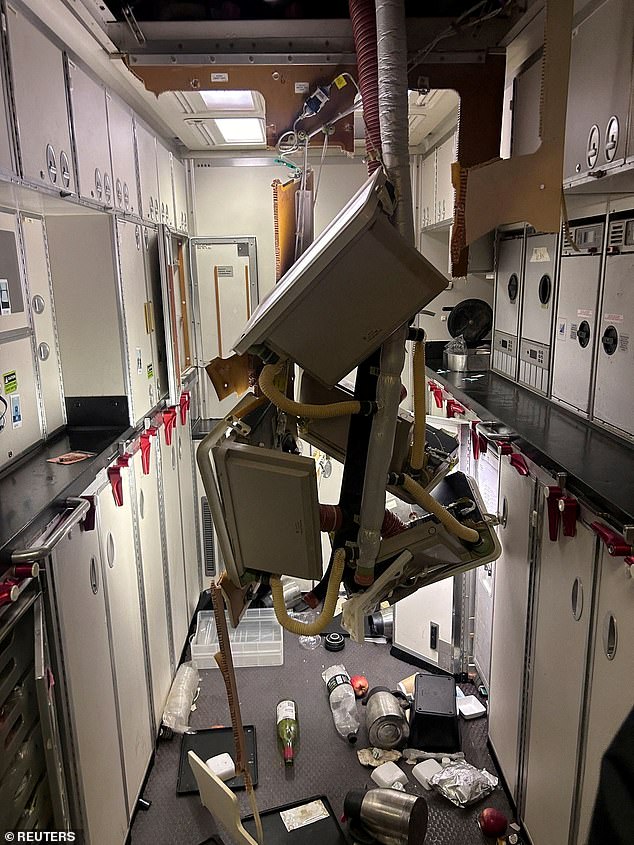
The interior of Singapore Airlines Flight SQ321 is pictured after an emergency landing at Suvarnabhumi International Airport in Bangkok, Thailand, May 21, 2024

Josh Silverstone, from Britain, who was injured during the Singapore Airlines Boeing 777-300ER flight, talks to reporters at Samitivej Srinakarin Hospital

Mia Stevenson was one of many Britons on the run

Geoff Kitchen, 73, suffered a suspected heart attack on the plane and eventually died
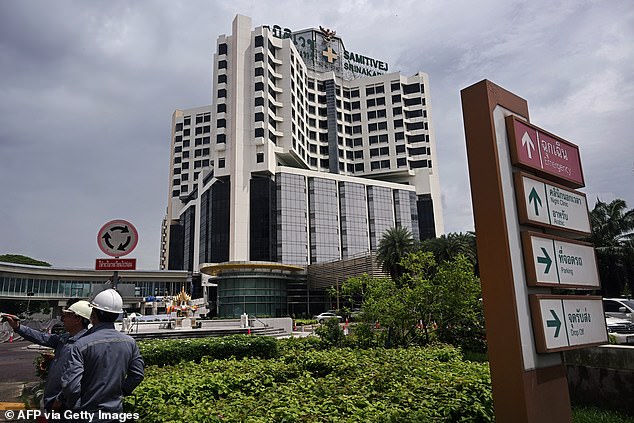
A general view shows the exterior of Samitivej Srinakarin Hospital, where some injured passengers were treated two days after the turbulence-hit Singapore Airlines flight SQ321 from London to Singapore in Bangkok on May 23, 2024
British student Mia Lawrence revealed how she ‘froze in fear’ after being catapulted from her seat on the ill-fated Singapore Airlines flight.
Other passengers were thrown from their seats as coffee and cups of water were thrown into the air and their mobile phones, shoes and pillows were thrown across the cabin.
Some feared they were about to die. Jim Silverstone, 24, said he paid for Wi-Fi on board for the first time ever so he could text his mother that he loved her.
Silverstone, from south London, was on his way to meet friends in Bali.
As he left hospital in Thailand yesterday, he described the ordeal as “just terrifying” as he was thrown to the ground as the Boeing 777 plummeted 6,000 feet in three minutes.
He suffered a cut on his cheek and a chipped tooth.
Another Briton, Mia Stevenson, told MailOnline: ‘I was partially asleep and the next thing I remember is just flying up and hitting the ceiling and then falling really hard into the aisle.’
Hospital chiefs could not reveal the names of those treated due to patient confidentiality.
But one of the women in intensive care is the widow of 73-year-old Geoff Kitchen, who is believed to have suffered a fatal heart attack.
Linda Kitchen is one of the passengers who suffered significant back injuries.

Adinun Kittiratanapaibool, director of Samitivej Srinakarin Hospital, speaks to the press about the treatment and condition of injured passengers two days after the turbulence-hit Singapore Airlines flight SQ321 from London to Singapore, in Bangkok on May 23, 2024
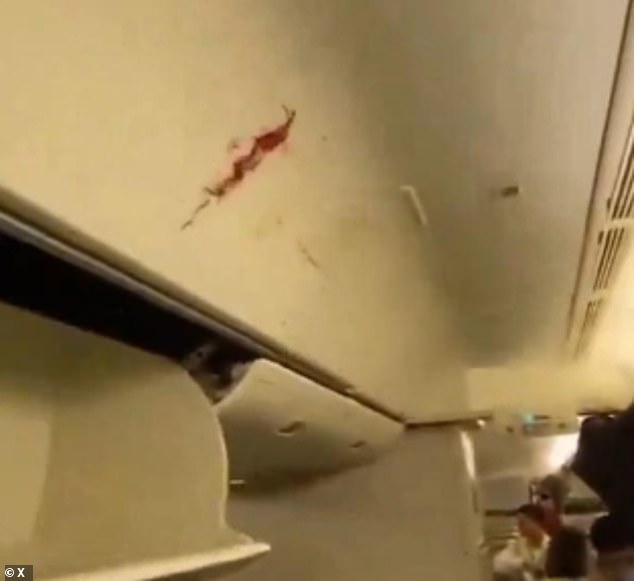
A bloodstain is seen on the overhead locker after turbulence

The interior of Singapore Airlines Flight SQ321 is pictured after an emergency landing at Suvarnabhumi International Airport in Bangkok, Thailand, May 21, 2024
Most people associate turbulence with heavy storms, but the most dangerous type is so-called clear air turbulence.
Wind shear can occur in wispy cirrus clouds or even in clear air near thunderstorms because differences in temperature and pressure create powerful currents of fast-moving air.
According to a 2021 report from the US National Transportation Safety Board, turbulence was responsible for 37.6% of all accidents at larger commercial airlines between 2009 and 2018. The Federal Aviation Administration, another US government agency, has said there were 146 serious injuries fallen due to turbulence from 2009 to 2021.
Tourism and aviation expert Anita Mendiratta, who lives in London, said the extreme turbulence was “extremely unusual”.
She said passengers should listen to instructions to keep their seat belts on, ensure carry-on luggage is stored safely when not in use, and store less items in overhead compartments.
“If there’s turbulence, those doors can open and all the stuff at the top, whether it’s our carry-on, our coats or our duty-free stuff, can become movable and pose a risk to all of us,” she said.
